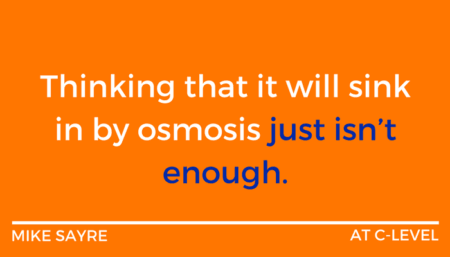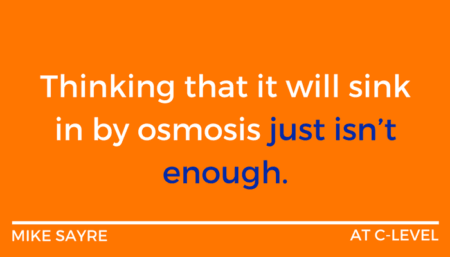At C-Level #15: Transformation Communications

Mike Sayre is a highly experienced and successful software, e-commerce, and manufacturing services CEO, COO, CFO, and Board Director. He is also the president & COO of Metcalf & Associates, a trusted partner inspiring and enabling perpetual innovation, evolution, and growth in leaders and their businesses. Mike was featured in Maureen Metcalf’s May 2017 “Innovative Leaders Driving Thriving Organizations” interview on VoiceAmerica entitled “7 Characteristics of Leadership 2020 In Practice: A CEO Story.”
In At C-Level #10–18, I write about three of the most successful transformations I’ve had the opportunity to lead in my career so far, following a seven-step transformation model like the Metcalf & Associates Innovative Leadership Transformation Model below.

Communicate
It is unlikely that you will ever over communicate in a transformation effort, unless what you are communicating does not resonate with your audience—and, in that case, it isn’t a matter of over communicating, it’s more likely that you are miscommunicating. Communication is effective when your audience feels you are sharing your passion and that you are authentic, see the path forward, and feel their contribution is vital to making a transformation.
Simply setting the example, saying it once, posting it on every wall, and thinking that it will sink in by osmosis just isn’t enough. You must live, breathe, and give testament what you believe every day!
So, before you start, you need to work with your team on the messages you are sending to your various stakeholder groups—your owners, board (if you have one), employees, customers, suppliers, and the various communities in which you live and work. Your messages need to be
- consistent with your vision, mission, and values,
- directional,
- important to your audience,
- delivered with an appropriate sense of urgency,
- clear and concise,
- translated into the languages the people in your organization speak and understand best, and
- communicated consistently and often by your transformation leadership team.
At first, writing the messaging, as well as potential questions and answers, with the transformation team may be helpful. After a brief time, it should become second nature to everyone if it is constantly and consistently reinforced by the team’s leader(s).
When was the last time you stood in front of the organization and discussed your vision, mission, and/or values? When was the last time, someone brought a major challenge to you and you said, “Well, our vision is ____, and we say that we value ____, so we should ____.”?
Here is how we communicated throughout the three transformations I outlined in At C-Level #10:
- Large Manufacturing Company. In our transformation to upgrade basic financial reporting controllers into true financial business partners in a large and growing company (our vision), we communicated our vision, plans and progress:
- at two to three regular or specially-convened controller conferences every year, where the controllers and their assistants traveled to our headquarters,
- during trips we made to our various business units to keep up with our colleagues and talk about our vision and plans,
- through conference calls and e-mail with the systems project team,
- calls, e-mail, and visits I made to our business units, and
- generally, not enough.
Yes, “not enough.” We communicated a lot on how we were getting the new system implemented and how our controllers were getting better training on the business and the new system. And, while we spent some time communicating our vision of the controllers becoming better business partners, we did not spend enough time communicating more precisely how they would do that with their new systems and training!
That’s not to say that we did not make significant progress. We made a lot of progress that had been needed for some time. But, did we communicate enough about our vision and the progress we had achieved towards it? In “At C-Level #16: Transformation Implementation and Measures of Success” I write more about this transformation.
Are there clear links between what everyone is doing in your organization today and, if you have them, your vision, mission, and values? What about your goals?
- Mid-Size Electronics Manufacturing Services Company. Leading a transformation “to be the best in the world at what we do,” with our mission to improve the lives of all our five stakeholder groups, left a lot of room for interpretation. There was a lot we did not know yet.
However, we did know that we had a basic command and control environment with a very high-revenue growth rate in low-to-no margin integration work. The combination was driving a high-pressure and negative working environment, inefficient and costly operations, unacceptable quality, poor on-time shipping performance, and low and inconsistent earnings. The good news was that we had revenue. We just had to figure out how to solve many of these other challenges before that revenue went away.
We started out doing what most companies do with their vision, mission, and values. We had posters made and hung them on the walls. We had wallet cards made and gave them to all employees. We had a couple of kick-off meetings. And that’s where we’ve seen a lot of companies stop.
But we continued. We had daily 15-minute order review meetings, daily and weekly Lean Manufacturing implementation meetings, weekly leadership team meetings, bi-weekly company update meetings, and company quarterly results meetings. In almost every meeting, we would ask people to take out their cards, read something from them, and/or talk about some examples where they were used or applicable, always pointing to the card and quoting from it. Our vision, mission and values were always front and center and a part of our daily lives.
More important and impactful than our meetings, was that we consistently communicated our vision, mission, and values through our actions. We simply walked the talk.
You know you have the right vision, mission, and values when you and your team are passionate about them, can talk about them, and live them out almost effortlessly every day.
Do you have posters of your organization’s vision, mission, and values hung up around your place of work? How often do you talk about those? When was the last time you discussed a particular challenge with your team and it was pointed out that the solution was already in your vision, mission, or values statement?
- Global Internet Payments Company. In our transformation journey to turn around the culture, and, in turn, the operational and financial performance of this 10-year-old company now hampered with a start-up mentality that was very difficult to scale, group communications were vital. However, individual communications with the leadership team around the almost daily challenges that came up were even more important.
Structured functional and cross-functional Agile meetings with top leadership involvement and support keeping the mission and values fully integrated into how those meetings were conducted, started breaking down the silo walls that had been built.
However, there were still competing priorities at the functional leadership level that needed to be re-prioritized for what the company was trying to achieve. That meant a lot of impromptu discussions with individuals and small leadership team groups caught-up in the siloed culture that had developed in recent years. It meant a lot of repetition talking about what the company was all about, how we could move forward more successfully together, and how the practical day-to-day application of our mission and stated values would help us accomplish that. Eventually, the repetition metamorphosed into muscle memory and the leadership team members felt empowered to communicate in and between the functional teams without any facilitation.
How much of your time do you spend facilitating discussions and/or making decisions for functional team leaders with competing priorities? Does or could your organization’s vision, mission, and values reduce the need for your personal facilitation time and free up that time up for higher-level strategic interactions, discussions, planning, and execution (with internal and external partners)?
Key takeaways from these transformations
You cannot communicate enough. Pull people in early and keep them engaged.
Take the time to craft messaging around your organization’s driving vision, mission, and values that can be clearly understood at all levels inside and outside your organization. You don’t want to have to adjust your messaging around your high-level purpose and operating guidelines for different groups. You want them all to be disciples. Communications must be easily understood and easy to repeat, so they can be ingrained in the organization and people can easily rally around them over the longer term.
Having said that, getting the various stakeholder groups on board requires that they know what’s in it for them and what they have to do to help make it happen. Those communications must be more tailored to the audience within the context of the broader overall messaging.
Communicate and gain support at all levels of the organization, starting with your board, your boss, and your team, before going broader across the organization. They should all be part of developing the desired future state and crafting the messaging that helps them buy in.
In “At C-Level #16: Implementing Transformations and Measuring Success,” we’ll look at how the transformations of these same three organizations were implemented, how people were further motivated and their success measured along the way, and what the key takeaways are that you may need to think about in preparing for your own organization’s transformative journey.
Thanks for following us! For more information or help, please visit us at www.Metcalf-Associates.com.





